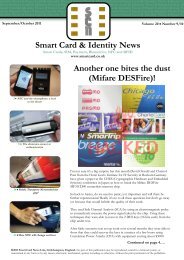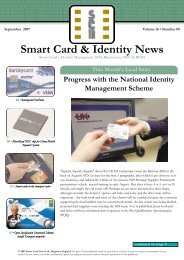Mifare, Oyster and ITSO Cards Hacked Smart Card & Identity News
Mifare, Oyster and ITSO Cards Hacked Smart Card & Identity News
Mifare, Oyster and ITSO Cards Hacked Smart Card & Identity News
Create successful ePaper yourself
Turn your PDF publications into a flip-book with our unique Google optimized e-Paper software.
<strong>Mifare</strong> (In)security Update January 2008<br />
By Dr David Everett, CEO, <strong>Smart</strong> <strong>Card</strong> Group<br />
David Everett<br />
<strong>Mifare</strong>: Little Security, Despite Obscurity was the title of the paper given at the 24th<br />
Congress of the Chaos Communication Congress that took place in Berlin on the 28th<br />
December 2007. Given by Karsten Nohl (University of Virginia) <strong>and</strong> Henryk Plötz<br />
but also involving Starbug from the Chaos Computer Club the presentation gave a<br />
first h<strong>and</strong> account of reverse engineering the Crypto-1 algorithm employed in the<br />
<strong>Mifare</strong> RFID chips. These chips are widely used particularly in the mass transit area<br />
such as the London transport <strong>Oyster</strong> card <strong>and</strong> the <strong>ITSO</strong> cards deployed across<br />
Scotl<strong>and</strong> <strong>and</strong> as also proposed for the new Dutch National public transport smart card<br />
scheme (OV chipcard).<br />
There have been lots of discussions over the security of the <strong>Mifare</strong> card particularly because of the extended<br />
business applications such as an ePurse being proposed for this platform. Expressions such as low security<br />
are thrown around in a way that could confuse or even misrepresent the platform. In any scheme it is the<br />
overall security that matters not the individual components. It is also fundamental to ensure that the<br />
components are used in the right way, in most high visibility failures it has been a protocol or procedure<br />
failure that has resulted in the end disaster. However memory cards such as <strong>Mifare</strong> do have restricted security<br />
functionality <strong>and</strong> when the cryptographic security relies on keeping the algorithm secret that is an additional<br />
risk that has now exploded. It should be noted that the researchers have not published their findings in detail<br />
(<strong>and</strong> may never do so) but they have publicly demonstrated not only that it is possible with limited equipment<br />
to reverse engineer the r<strong>and</strong>om number generator <strong>and</strong> the algorithm but also to point out many weaknesses<br />
in the actual Crypto-1 implementation.<br />
The <strong>Mifare</strong> chip technology is based on a simple contactless memory device with discrete logic to provide<br />
some security functionality across the air gap with the reader (i.e. at the radio frequency level). This<br />
technology is proprietary to Philips Semiconductors <strong>and</strong> requires their IPR to be available in both the <strong>Smart</strong><br />
<strong>Card</strong> chip <strong>and</strong> the <strong>Mifare</strong> reader. In practice this means that both the smart card <strong>and</strong> the reader need to have<br />
a Philips (or a <strong>Mifare</strong> licensed chip, e.g. Infineon) chip embedded within them. The original <strong>Mifare</strong> 1K<br />
memory was introduced in 1994 <strong>and</strong> there are now 6 chips in the <strong>Mifare</strong> range from NXP (previously Philips<br />
Semiconductors);<br />
• <strong>Mifare</strong> Classic (1 Kbytes of EEPROM non-volatile memory),<br />
• <strong>Mifare</strong> 4K (4 Kbytes of EEPROM),<br />
• <strong>Mifare</strong> DESFire (4 Kbytes of EEPROM),<br />
• <strong>Mifare</strong> Ultralite (64 bytes of EEPROM),<br />
• <strong>Mifare</strong> ProX (1 Kbytes or 4 Kbytes <strong>Mifare</strong> emulation in a micro controller chip. Total chip<br />
EEPROM including <strong>Mifare</strong> emulation memory is 16 Kbytes)<br />
• <strong>Smart</strong> MX (a more advanced <strong>Mifare</strong> ProX replacement series with up to 72 Kbytes of<br />
EEPROM).<br />
The <strong>Mifare</strong> ProX <strong>and</strong> the <strong>Smart</strong> MX are micro controller based chips <strong>and</strong> provide the <strong>Mifare</strong> functionality as<br />
an emulation in the chip. These chips are used for example by the IBM JCOP30 <strong>and</strong> JCOP40 Java <strong><strong>Card</strong>s</strong><br />
respectively. The discussion that follows relates to the Classic 1k <strong>Mifare</strong> but the arguments would hold for<br />
most other memory cards.<br />
<strong>Mifare</strong> <strong>Card</strong> Operation: The <strong>Mifare</strong> 1K card has its 1 Kbyte memory arranged as 16 sectors, each with 4<br />
blocks of 16 bytes. The last block in each sector stores two keys, A <strong>and</strong> B, which are used to access<br />
(depending on the access conditions also set in this block) the other data blocks. The <strong>Mifare</strong> reader interacts<br />
with the card as follows; 1) Select card (ISO 14443 allows multiple cards in its field), 2) Log-in to a sector (by<br />
providing key A or key B) <strong>and</strong> 3) Read, Write, Increment, or Decrement a block (must conform to the access<br />
conditions). The Increment <strong>and</strong> Decrement operations allow the block to be treated as an electronic purse.<br />
<strong>Smart</strong> <strong>Card</strong> & <strong>Identity</strong> <strong>News</strong> • January 2008<br />
14
















